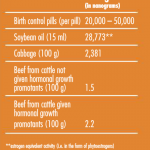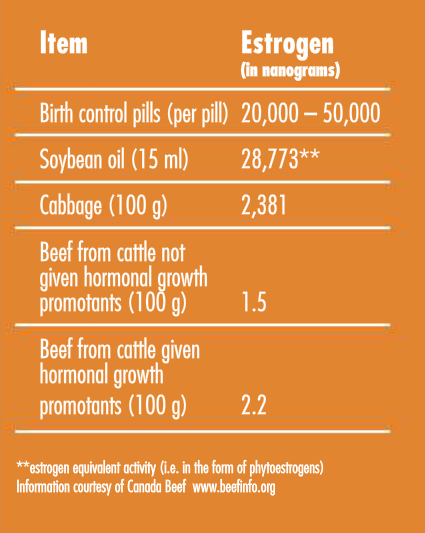
The truth about hormones in meat.
 THIS IS A SUPER CONFUSING OUT OF CONTEXT GRAPHIC from Saskatchewan Agriculture.
THIS IS A SUPER CONFUSING OUT OF CONTEXT GRAPHIC from Saskatchewan Agriculture.
Don’t be scared of cabbage!!
Let me deconstruct it for you so that you don’t have to spend hours studying to figure out what is ‘off’ about this message (references at the bottom).
First we need a little context here, so we can look at this subject from a systems perspective, not in isolation (which is basically what this info graphic is doing, making it very confusing for the consumer).
I will start with phytoestrogens and then I will get to the beef part, because this graphic is misleading, without seeing the bigger picture.
Phytoestrogens are not bad and they are NOT actual hormones, although they are similar in structure and can block estrogen receptor sites. Here is a link to my soy article deconstructing the controversy:
Here is a link to my soy article deconstructing the controversy: http://www.nutritionwisdom.ca/sensational-soy/
Phytoestrogens are not bad for already healthy people who do not already have severe symptoms of estrogen dominance (although the concentration in soy is cause for concern for people who eat processed soy products and babies who drink soy formula).
The way north americans consume soy is not at all comparable to how it is traditionally consumed in Asia (different ballpark altogether). Vegans eat too much of it and so does everyone who eats processed food because it is a ‘filler’ in just about everything.
The reason there are phytoestrogens (phyto meaning plant) in meat is because of what the animals are fed. Which is why some super sensitive people, can NOT eat conventional animal products, because the animals are fed soy – and it triggers their estrogen dominance symptoms. They should eat meat from animals who are fed their natural diet (as would be best for all humans in general).
There is no such thing as hormone-free beef, even if they didn’t add any. Hormones are a naturally occurring substances that all animals and mammals produce.
So the whole point of this infographic is questionable. It is a marketing ploy (obviously) intended to minimize people’s concerns about hormones in general by focusing on phytoestrogens and making them the ‘bad guy’ and saying hey look “we hardly have any of THOSE in our product”.
Plus, they make the numbers look extreme because usually these things are measured in micrograms, not nanograms which makes cabbage look like it is really high in phytoestrogens, but in relationship to other plants it is actually has a much lower content than the majority of phytoestrogen rich foods. However, when I converted it to nanogram, the cabbage converted to 80,000 nanograms using an online calculater, not 2381 as the photo shows! And that is both based on 100g so I don’t know why they would post it as less when trying to make their point. It is probably due to the reality that phytoestrogens in meat are just residue from the plants the animals are eating and so in order to give the phytoestrogen content a number, they had to make it nanogram. But because it would seem so outrageous, people might actually do their research to confirm that number (seems intentionally misleading to me, but maybe just an error?)
They are probably using this info graphic to come out publicly that synthetic and bio identical hormones are in fact used in the conventional farming of beef (because for a while there, everyone thought that Canadian meat was free of added hormones and it was JUST the evil american farmers using them).
Although, it is still not legal in Canada to use (rBST) a synthetic growth hormone that is approved in the US for dairy cattle. Health Canada has approved three bio identical hormones and three synthetic hormones for use in cattle in Canada.
It is the nature of our society to be short sighted, instead of considering the accumulative affect of exposure to exogenous hormones (meaning ones not made in the body).
Phytoestrogens are less of a concern, I would be more concerned about endocrine disrupting xeno estrogens (of which synthetic hormones are) that have been indicated in many conditions including: breast, prostate and testicular cancer, obesity, infertility, endometriosis, early onset puberty, miscarriages and diabetes.
Examples of harmful xeno estrogens: birth control pills, petro chemically-derived pesticides, herbicides and fungicides, Bisphenol A (used in plastic bottles, containers and almost all food-can liners, solvents, found in nail polish and polish remover, glue, cleaning supplies, car exhaust emulsifiers in soaps, plastics etc.
With all that exposure on a day to day basis, do we now also want it added to our food? I for one don’t.
Let’s face it, the added hormones are not for the well-being of the animals, nor to improve the nutritional value of the food, but they are there to increase production and make the meat cheaper to buy.
I am personally willing to pay more for better quality and healthier food. I have been eating organic dairy products even in the days when I made minimum wage. Back then I just ate organic dairy (since I was a vegetarian).
I eat meat now, but I choose quality over quantity. And so I can pretty much guarantee that I don’t spend more than the average meat eater on meat, I just eat less of it. Many people eat too much anyway. Instead of complaining about the cost of good quality meat, just eat less and it will even out in the end. And we get to be healthier in the process.
We can also learn a lot from bio-identical hormones and synthetic hormones prescribed to humans to look at what the impact could be. What is synthesized in a scientific lab is not the exact chemical structure as what is organically derived from nature.
Even if it is chemically structured the same (bio identical hormones) I want to know exactly what was used to create that synthetic substance? Synthetic hormones are not created structurally the same as human endogenous hormones, and that’s why they have side effects.
“While synthetic hormones can mimic the effects of endogenous hormones on certain biological pathways, they rarely offer the same effectiveness at a deeper, molecular level. Bioidentical hormones mimic the affinity of human endogenous hormones; therefore they are effective on more biological pathways, at all levels. Because bioidentical hormones are an exact structural replica of endogenous hormones, side effects are rarely observed.”
But there actually are side effects of bio identical hormones too: women who have had breast cancer or endometrial cancer, strokes, or blood clots would not want to take bio-identical hormones.
At the end of the day, I prefer to eat food as nature intended. I don’t want to eat synthesized hormones, nor be part of the experiment. I avoid synthetic chemicals where ever I do have control over that, including choosing to purchase organic grass fed (not just grass finished) meat that has no additional hormones added.
If you really want to know how to avoid estrogen dominance and heal your hormones, listen into this free ‘Hormone Harmony’ training: https://sherry-rothwell.simplero.com/page/73858
I am sure you are going to LOVE it! It is straight talk about what it really takes to heal.
References:
http://www.womenlivingnaturally.com/articlepage.php?id=73
http://www.everydayhealth.com/menopause/bio-identical-hormone-treatment.aspxhttps://www.bodylogicmd.com/faq/what-are-synthetic-hormones
https://www.organicconsumers.org/scientific/growth-hormones-fed-beef-cattle-damage-human-health
http://www.hc-sc.gc.ca/dhp-mps/vet/faq/growth_hormones_promoters_croissance_hormonaux_stimulateurs-eng.php
http://www.thehealthybutcher.com/organics.html

